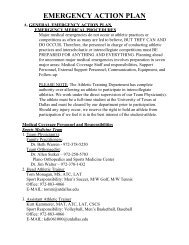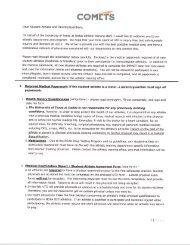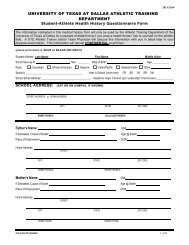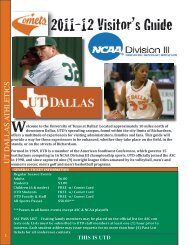Sickle Cell Form/Waiver - University of Texas at Dallas
Sickle Cell Form/Waiver - University of Texas at Dallas
Sickle Cell Form/Waiver - University of Texas at Dallas
You also want an ePaper? Increase the reach of your titles
YUMPU automatically turns print PDFs into web optimized ePapers that Google loves.
Centerfor Disease Control "Fact Sheet" on <strong>Sickle</strong> <strong>Cell</strong> DiseasentJp.11-!:1 r{\r.sd9.sq/n_cb d d dft&_Uese]|!1c,_tdlilt I<strong>Sickle</strong> CclI Disease<strong>Sickle</strong> cell discase (SCD) is a group <strong>of</strong>inheriled red blood cell disorders. Healrhyrsd blood cells are round, and they move through small btood vessels to carryoxygen lo all parts <strong>of</strong>the body. In SCD, the red blood cells become hard andsticky and look like a C-shaped farm tool called a "sickle." I'he sickle cells dieearly, rvhich causes a constant shortage <strong>of</strong>red blood cells. Also, rvhen they travelthrough small blood vessels" they get stuck and clog the blood florv. 'I his cancause pain and olher serious problenrs.Sicklc <strong>Cell</strong> TraitIIbAS - People who have this fomt <strong>of</strong>sickle cell disease inherit one sickle cellgene and one normal gene. This is called sickle cell trait. People rvith sickle celltrait usually do not havc any <strong>of</strong>the symptonts <strong>of</strong>the disease and live a normal life,but they can pass the disease on to their children.Iliagnosis<strong>Sickle</strong> cell trait is diagnosed rvith a simple blood test. People <strong>at</strong> risk <strong>of</strong>havingsickle cell trait can talk to a doctor or health clinic about getting lhis test.D<strong>at</strong>a & St<strong>at</strong>istics<strong>Sickle</strong> cell disease affccts millions <strong>of</strong>people throughout the $orld and isparticularly common among those rvhose ancestors conre irom sub-SaharanAfrica, Spanish-speaking regions in rhe Wcslem Hemisphere (Sourh America, theCaribbean, and Central America), Saudi Arabia, India, and Mcditerraneancounlries such as Turkey, Grecce, and ltaly.In the Uniterl St<strong>at</strong>esr. SCD affccts an estim<strong>at</strong>ed 70,000 to 100,000 Americans.'''The diseaso occurs in about I out <strong>of</strong>every 500 African Anrericansbinhs.The disr.ase occurs in about I out <strong>of</strong>every 36,000 Hispanic Americansbirths.Sicklc cell trait occurs in about I in 12 African Americans.ComplicntionsIt is possible for a person rvith sickle ccll trait to espcrience complic<strong>at</strong>ions <strong>of</strong>sickle cell disease, such as splenic sequestr<strong>at</strong>ion, "pain crisis," and, rarely, suddende<strong>at</strong>h.Hand-Foot SvndromeThis is usually the first symptonr <strong>of</strong> SCD. Srvclling in the hands and feet, <strong>of</strong>tenalong rvith a fever, is caused by lhe sickle cells gening stuck in the blood vesselsand blocking the florv oiblood in and out <strong>of</strong>the hands and feet.Tre<strong>at</strong>mentPain medicine and fluids, such as w<strong>at</strong>er.Pain "Episode" or "Crisis"This is the most common complic<strong>at</strong>ion, and the top reason th<strong>at</strong> people with SCDgo to the emergcncy room or hospital. When sickle cells travel through smallblood vessels, lhey can get stuck and clog rhc blood florv. 'lhis causes pain th<strong>at</strong> canstart suddenly, be mild to severe, and can last for any length <strong>of</strong>time.PrevenliotrThere are simple steps th<strong>at</strong> pcople lvith SCD can take to help prevent and reducethe number <strong>of</strong>pain crises:' Drink plenry <strong>of</strong> rv<strong>at</strong>er.. 'Iry not to get too hot ortoo cold.o Try to avoid places rvirh high altitudes (flying, mountain climbing, orcities rvirh a high altirude).'Try to avoid places or situ<strong>at</strong>ionswith lorv oxygen (mountain climbingor exercising extremely hard, such as in military boot camp or whentraining for an <strong>at</strong>hletic competition).' Adults wrlh severe sicklc cell disease can take a medicine calledhydroryurea 1o hclp rcduce the number <strong>of</strong>pain crises.. People taking h1'droryurea must be checked olien by a doctor becausethe medicine can cause serious side efGcts, including an increascd risk <strong>of</strong>dangerous inlcctionsAnemiaThis is a very common complic<strong>at</strong>ion. With SCD, the red blood cclls die early. I hismeans there alo not enough heahhy rcd blood cells to carry o\ygcn throughout thebody. When this happens, a p!'rson nlight have:'o'''t't'TirednessInilabilityDizziness and lightheadednessFast heart r<strong>at</strong>sDifliculty bre<strong>at</strong>hingPale skin colorJaundice (yellorv color to thc skin and rvhites olthe eyes)Slorv groulhDelayed pubertyTrertmentBlood transfusions are used lo tre<strong>at</strong> severe anemia. A sudden *orsening <strong>of</strong>anemiaresulting fiom infcction or enlargement olthe splecn is a common reason lbr <strong>at</strong>ransfirsion.Acute Chest SvndrorneThis can bc lifc-threalening and should be tre<strong>at</strong>cd in a hospital. It is sinrilar topneumonia and symptoms includc chest pain, coughittg. difficulty bre<strong>at</strong>hing, andPreYentionAdults rvith severe SCD can take a medicine called hydroxyurea to help preventacule chest syndrome. People taking hydroryurea must be s<strong>at</strong>ched closelybecause the medicine can cause serious side effects, including an increased risk oldangerous infections.A person rvho is on bed rest or has recently had surgery can use an incenlivespirometer, also called "blorv bottlc," to help prevent acute chest syndrome.Tre<strong>at</strong>mentDepending on the cause, tre<strong>at</strong>ment migbt include oxygen, nlcdicinc to tre<strong>at</strong> aninfection, medicine to open up blood vessels to improve blood florv, and bloodfever-transfusions-Splenic Sequestr<strong>at</strong>ionThis can be life-thrcalening and should be tre<strong>at</strong>ed in a hospital. It happens when aIarge nunrber <strong>of</strong>sickle cells get trapped in the spleen and causc it to suddenly getlarge. Symptoms include sudden rveakness, pale lips, fast bre<strong>at</strong>hing, e\treme lhirst,abdominal (belly) pain on the left sidc <strong>of</strong>body. and fast heart be<strong>at</strong>.Parents <strong>of</strong>a child rvith SCD should learn horv lo feel and measure the size <strong>of</strong>theirchild's spleen.PreventionFor those lvho have had a very severe, Iife-thealening episode <strong>of</strong>splenicsequestraiion or who have had many episodes in the past, it might be necessary tohave regular blood transfusions or the spleen can be removed (called splenectomy)to stop it {iom happenfng again.Trealment'fre<strong>at</strong>ment typically is a blood transfusion.







